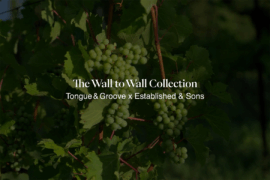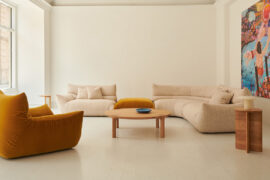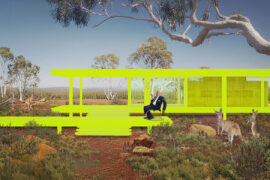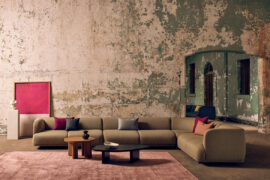Finnish architectural philosopher Juhani Pallasmaa was recently in Australia to deliver a paper at the National Architecture Conference. Indesign’s Editorial Director Paul McGillick spoke to him about his writing and its inspiration.
April 29th, 2011
On Music
Music has always been important to me. I occupy musical spaces as I listen to music. And silence, which is an important part of music, is important in architecture. I’m worried that much of contemporary architecture makes too much noise – mental noise. I appreciate architecture where silence is the world rather than adding to the pollution of noise.
Every experience of space is multi-sensory and in my view, visual experience contains tactile and acoustic experiences, or implied haptic experiences. When we look we actually touch.

Juhani Pallasmaa, Driveway Square
My favourite philosopher, Maurice Merleau-Ponty has a beautiful saying: “With vision we touch the sun and the stars”. I have become very interested in this implied touch in vision and I think this is where much contemporary architecture falls short. It doesn’t invite tactile contact that comes through vision, whereas natural surroundings and most old architecture and indigenous architecture has that richness of haptic experience.
On Art
For the last 30 years I have not read nor even looked at architecture books. I only consult architecture books in relation to my writings when I have to refer to some specific work. Otherwise, I look at books on painting.
All the arts are engaged in the same issue, and that is: How does it feel to be a human being in this world?
I find architectural work, particularly of my contemporaries, less sincere and less touching than painters and poets and composers. And I think it is simply because architecture is covered by so much coarse rationalisation, codes and inspections that, in the end, if the architect has some energy left he can think of the poetic dimension.
I find it much easier as a teacher to teach architecture through paintings, cinema, poetry than by directly showing architectural examples. Because in a poem you don’t have to explain anything. The poetic image hits the listener, whereas with architecture you have to do a lot of explanation.

Fra Angelico, The Annunciation. Detail
Art has always been central to me. Several times a week I look up early Renaissance paintings in my library. I have a very good art library – about 10,000 books. I find such enormous inspiration in that almost childlike world of Fra Angelico and Piero della Francesca.

Piero della Francesca, The Nativity. Detail
Almost every single painting in that era depicts architecture. And that architecture is reduced to the size of human beings as in icon paintings. This was an important phase in the development of human consciousness – that is, the separation of ’I’ – the first person – from the world.
This is why that setting and the individual – that dialogue – is so central in early painting. That is also so educational for me as an architect.
On Writing
Maybe I have a method. For example, I usually only read books recommended by one of my trusted friends, which reduces the amount of reading. There is too much useless reading in today’s world. And my reading is usually related to my writing.
I have just published my 35th book – The Embodied Image, which could be my most important book. I am currently working on 8 book projects. I have also written 350 essays.
I have adopted the motto of the great Swedish painter, Isaak Grunevald: “Whenever I have an idle moment, I work.” Life becomes a unity.
I can’t think of myself sitting in a beach chair. The world is too exciting a place, and too mysterious.
INDESIGN is on instagram
Follow @indesignlive
A searchable and comprehensive guide for specifying leading products and their suppliers
Keep up to date with the latest and greatest from our industry BFF's!

London-based design duo Raw Edges have joined forces with Established & Sons and Tongue & Groove to introduce Wall to Wall – a hand-stained, “living collection” that transforms parquet flooring into a canvas of colour, pattern, and possibility.

A curated exhibition in Frederiksstaden captures the spirit of Australian design
Wilkhahn celebrated the launch of the Chassis chair by Stefan Diez with a party on Sydney’s Cockatoo Island. Guests were treated to mulled wine on arrival on the frosty night of Thursday 12 May. Special guest Stefan Diez presented his new design to a crowd of over 500 people.

What turns a team into a community? Following a whirlwind tour of Europe’s most successful workplaces, Heidi Smith of Gray Puksand, shares the team’s findings.
The internet never sleeps! Here's the stuff you might have missed

As the next event in a series of discussions centring on Richard Francis-Jones’ book comes to Brisbane, we hear directly from the speakers on fences, villas and the importance of critical community.

With the Evershield® Anodising 50-Year Warranty, AAF offers peace of mind that architectural aluminium will remain vibrant, resilient, and beautiful for generations.

Discover the range designed to let people gather and ideas flow

Tickets for Architecture & Design’s 2025 Sustainability Summit are on sale. This 19 November, engage in ten expert-led panels on urban planning, AI, and circular economy. Join industry leaders in Sydney or online, and gain CPD-accredited insights to drive innovative, sustainable building solutions shaping our shared future. Plus on demand access to recordings.